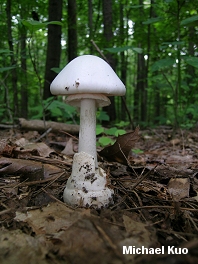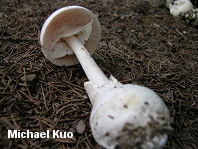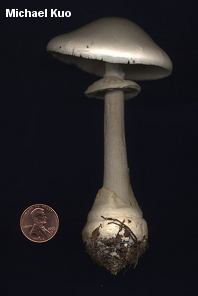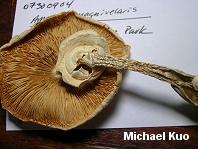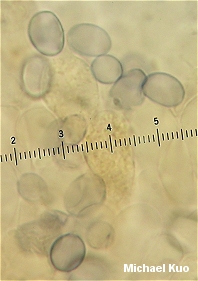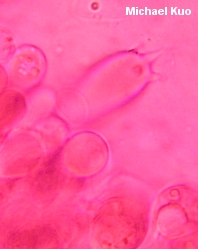| Major Groups > Gilled Mushrooms > Pale-Spored > Amanita > Amanita magnivelaris |

|
Amanita magnivelaris [ Basidiomycetes > Agaricales > Amanitaceae > Amanita . . . ] by Michael Kuo This infrequently collected "destroying angel" is a member of the Amanita elliptosperma species group, which contains white species with sacks around the stem bases, four-spored basidia, ellipsoid spores, and caps that do not react to KOH. The entire group is, in my humble opinion, poorly understood and in need of contemporary revision based on ecological data and DNA research . . . but for the time being, at least, Amanita magnivelaris is putatively distinct from other members of the group on the basis of its notably thickened, ample ring. The original description of Amanita magnivelaris was based on a New York state collection, and came from Charles Peck (1897):
Description: Ecology: Mycorrhizal with various hosts--I have collected it under loblolly pine and under Norway spruce; Rod Tulloss (cont. upd.) documents it under various hardwoods and conifers; growing alone or scattered; summer and fall; apparently distributed around the Great Lakes and in the northeast. Cap: 4-10 cm; convex, becoming broadly convex, broadly bell-shaped, or nearly flat in age; bald or, when young, with scattered volval patches; dry or sticky; white to ivory; the margin not lined. Gills: Free, or nearly free, from the stem; close or crowded; with frequent short-gills; white. Stem: 6-12 cm long; 1-2 cm thick; tapering to apex; with an enlarged, bulbous base that measures up to 4 cm in diameter and features a tapering, rooted underside; somewhat shaggy or nearly bald; white; with a persistent, notably thickened, felty, high, skirtlike ring that may feature a grooved upper surface; with a white, sacklike volva encasing the base. Flesh: White throughout. Odor: Reminiscent of raw potatoes, or not distinctive. Spore Print: White. Chemical Reactions: KOH negative on cap surface. Microscopic Features: Spores 8-11 x 5.5-8 µ; smooth; ellipsoid; amyloid. Basidia without clamps; 4-spored. Pileipellis a cutis or ixocutis. Lamellar trama bilateral. REFERENCES: Peck, 1897. (Saccardo, 1899; Tulloss, cont. upd.) Herb. Kuo 08250604, 07300904. This site contains no information about the edibility or toxicity of mushrooms. |
© MushroomExpert.Com |
|
Cite this page as: Kuo, M. (2013, March). Amanita magnivelaris. Retrieved from the MushroomExpert.Com Web site: http://www.mushroomexpert.com/amanita_magnivelaris.html |
